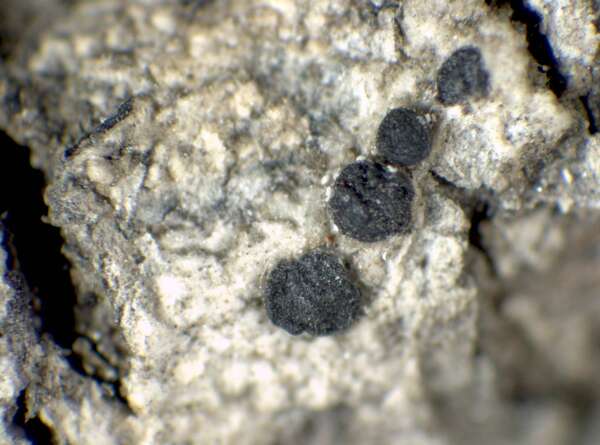Tetramelas chloroleucus (Körb.) A. Nordin
Lichenologist, 36: 356, 2004. Basionym: Buellia chloroleuca Körb. - Parerga Lichenol.: 191, 1860.
Synonyms: Buellia parasema var. saprophila (Ach.) Körb.; Buellia poeltii T. Schauer; Buellia punctata var. saprophila (Ach.) Anzi; Buellia zahlbruckneri sensu T. Schauer; Tetramelas poeltii (T. Schauer) Kalb
Distribution: N - Frl, Ven (Giralt & al. 2000, Nascimbene & Caniglia 2003c, Thor & Nascimbene 2007), TAA (Giralt & al. 2000, Nascimbene & al. 2006e, 2007b, 2008c, 2022, Nimis & al. 2015), Lomb (Giralt & al. 2000, Gheza & al. 2023), Piem (Isocrono & al. 2004), Emil (Fariselli & al. 2020). C - Abr.
Description: Thallus crustose, episubstratic, granular to rimose-areolate, rather thin, dark to pale greenish grey or more rarely ochraceous, rarely delimited by a black prothallus. Medulla white, lacking calcium oxalates, I-. Apothecia lecideine, black, 0.2-0.8(-1) mm across, soon sessile, with a flat to finally convex, epruinose disc and a thin, soon excluded proper margin. Proper exciple narrow, c. 60 µm wide laterally, Aethalea-type, the inner hyphae hyaline, prosoplectenchymatous, the outer hyphae parallel and usually strongly brown-pigmented; epithecium brown, N-; hymenium colourless, 80-90 µm high, not inspersed with oil droplets; paraphyses simple to moderately branched, apically swollen, with a brown pigment cap; hypothecium brown. Asci 8-spored, clavate to cylindrical-clavate, the apical dome K/I+ dark blue with a pale, conical-pointed apical cushion (axial mass), the wall I-, but the thin outer gel I+ blue, Bacidia-type. Ascospores 1-septate, brown (often paler at apices), narrowly ellipsoid, not constricted at septa, sometimes slightly curved, (11-)16-22(-27) x (5.5-)7-9(-11) µm, Buellia-type, but sometimes slightly thickened at apices (Callispora-type) when immature, the wall faintly microrugulate. Pycnidia rare, black, globose, unilocular, the conidiogenous cells mostly terminal. Conidia bacilliform, 3-6.5 x 0.5-1 µm. Spot tests: K+ weakly yellow, C+ pale yellow-orange, KC+ orange, P-, UV+ weakly to bright orange. Chemistry: 6-O-methylarthothelin, plus variable amounts of arthothelin with isoarthothelin, atranorin, and other xanthones. Note: a mainly boreal-montane species found on lignum, more rarely on bark, especially of conifers, with optimum in the upper montane belt. See also note on B. erubescens.
Growth form: Crustose
Substrata: lignum
Photobiont: green algae other than Trentepohlia
Reproductive strategy: mainly sexual
Commonnes-rarity: (info)
Alpine belt: absent
Subalpine belt: rather rare
Oromediterranean belt: absent
Montane belt: rare
Submediterranean belt: absent
Padanian area: absent
Humid submediterranean belt: absent
Humid mediterranean belt: absent
Dry mediterranean belt: absent

Predictive model
Herbarium samples
Growth form: Crustose
Substrata: lignum
Photobiont: green algae other than Trentepohlia
Reproductive strategy: mainly sexual
Commonnes-rarity: (info)
Alpine belt: absent
Subalpine belt: rather rare
Oromediterranean belt: absent
Montane belt: rare
Submediterranean belt: absent
Padanian area: absent
Humid submediterranean belt: absent
Humid mediterranean belt: absent
Dry mediterranean belt: absent

Predictive model
| Herbarium samples |
 INDEX FUNGORUM
INDEX FUNGORUM
 GBIF
GBIF
 DOLICHENS
DOLICHENS





